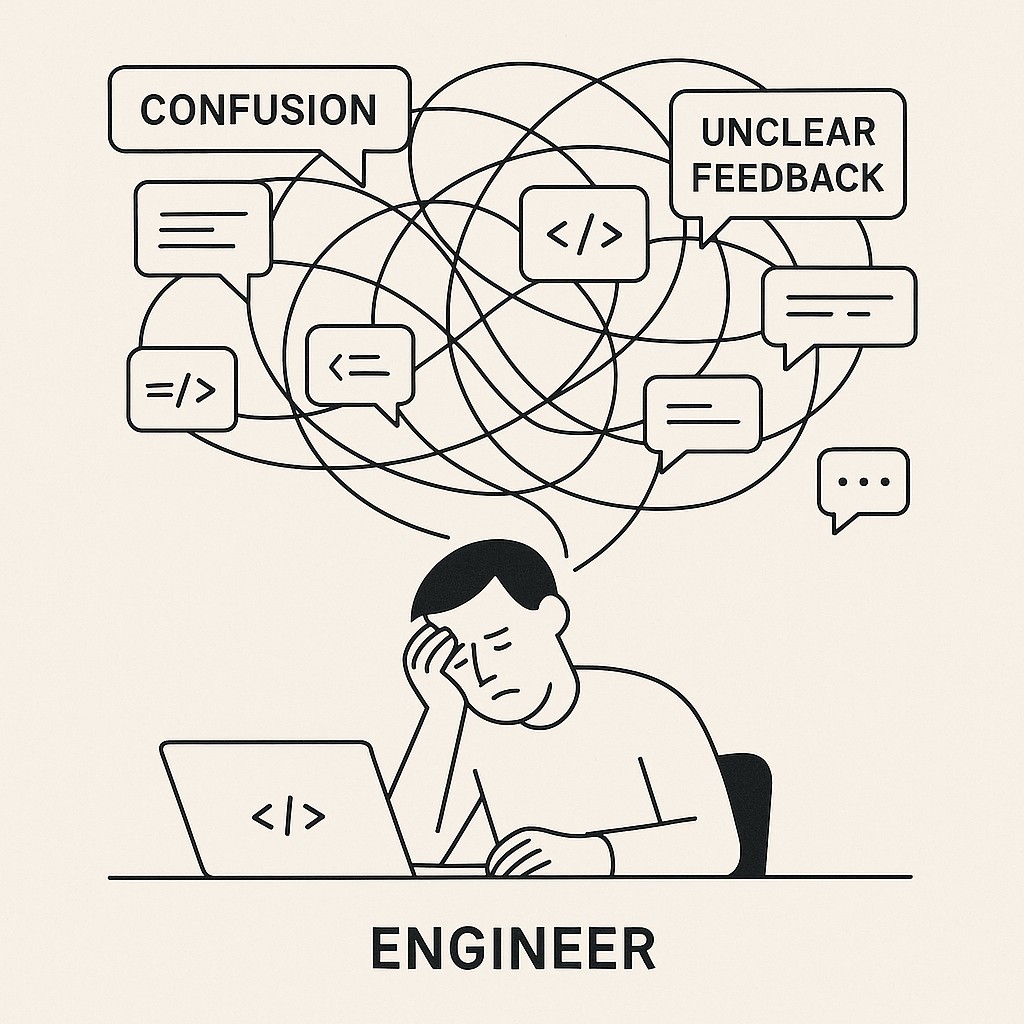Fix Engineering Feedback Bottlenecks: A Proven One-Week Plan
Fix Engineering Feedback Bottlenecks: A Proven One-Week Plan

Start With the Real Bottleneck to Fix Engineering Feedback Bottlenecks
Before we dive in, let’s start with a quick poll—I want to hear from you. Day one, fresh slate. What’s your biggest sticking point when it comes to feedback?
Take 30 seconds. Scan your last week. Where do you hit the wall with feedback—giving it, asking for it, or acting on it?
Here’s what stood out in the poll responses. Nearly every engineer is comfortable with code reviews. That’s a familiar arena. But even technically strong teams trip up when the feedback moves beyond code. Real clarity, challenge, and candor—those are still rare.
Let’s be honest. We’ve all seen it. Avoidance creeps in. Defensiveness derails a conversation before it even starts. Or the requests themselves are so vague (“can you check this?”) that clarity is out of reach. In engineering, this isn’t just about personal growth. It cuts deeper. To fix engineering feedback bottlenecks, we have to confront how muddy feedback drags down code quality, stalls technical decisions, and saps a team’s creative edge.

So here’s the promise for this series: we’ll improve engineering feedback. You’ll pinpoint your feedback bottleneck in seconds, and you’ll get a one-week plan to tackle it. Why this focus? Because feedback fuels action, and improving your weakest link is what actually moves the needle—across code, products, even research. Let’s get clear and move fast.
Feedback Is a Skill—Start Where It’s Hardest
Let’s be direct. You have to build feedback skills, and they’re among the hardest soft skills to get right. If you’ve struggled with it, you’re not alone. Most engineers I know—myself included—have hit that wall more times than we’d like to admit.
But here’s something that shifts the whole conversation. Feedback isn’t a personality trait. It’s a skill. And like any skill, it gets sharper the more you practice it. Six months ago, I used to think mastering feedback was just about phrasing things clearly. Turns out, fewer than half of studies actually focus on connecting feedback with learning objectives—the process is more layered than just delivery alone. There’s real room for growth, not just for natural “good communicators.”
Here’s where things get practical. As engineers, we know that every system—whether it’s a software app or a feedback loop—can only move as fast as its tightest constraint. The process gets capped by the weakest part, not the average. The reality: focusing on your biggest constraint first can trigger rapid, visible improvement across your team’s value stream. Throughput jumps when you address the main bottleneck source. If I’m honest, I spent years trying to optimize every part of my feedback process except the part I found most uncomfortable. But the first step—and the only one that actually moves you—is knowing where you struggle most.
To make this actionable, I use five feedback focus areas: asking for feedback, giving direct feedback, challenging product or tech decisions, responding to tough feedback, and closing the loop. Today your job is just to pinpoint which one trips you up most often. That’s it—identification. The rest of the series will dig into how we strengthen each, but it starts with knowing your friction point.
You might wonder if picking one area to focus on means ignoring team dynamics, or maybe you worry that your feedback style is set in stone. I get it. But narrowing your attention isn’t about being narrow. It’s about leverage. By zooming in on the single bottleneck, you give yourself a better shot at unlocking clarity and momentum for your entire team. Think of it like fixing the slowest endpoint in your pipeline—everything speeds up once you do.
So, be honest, pick the one area that slows you down, and let’s use it as leverage. This series isn’t about huge time investments or personality overhauls. It’s feedback as a technical skill, open to every engineer. That’s where real change starts.
Diagnose Your Bottleneck Fast
If you want this to have real impact, you’ve got to start by learning to diagnose feedback bottlenecks in action. Not in theory. So let’s map the five most common feedback constraints to actual moments in our workday—no workshops required. Start with pull requests.
Do your comments drift into politeness at the expense of clarity (“maybe double-check this when you have time?”) or get bogged down in details while sidestepping the core problem? When it comes to design docs teams use, listen for how often challenging a technical decision turns into an “optional suggestion” rather than a push to clarify tradeoffs or rethink an approach. Watch your standups and DMs. Is asking for feedback mostly a generic “thoughts?” or do you spell out what would actually change your mind? The toughest feedback to receive often stalls out in defensiveness (“I’ll look into it”) or just gets ignored. And after the dust settles, closing the loop matters. In reviews, does the conversation end with “fixed, thanks” or does someone make sure the original issue got resolved for the team’s future work? These signals aren’t hypothetical. They’re fingerprints you’ll spot in your own messages, meetings, and review threads.
I keep doing this: writing “polished” review comments that sidestep the hard ask. Sometimes I’ll skip saying, “I’m not convinced by this approach—can you show where it’s necessary?” and instead just toss in wordier, softened suggestions. It feels easier in the moment, but it actually blurs what needs real attention.
There was a stretch not too long ago when I thought the problem was just tone. On a Monday, I found myself rewriting one PR comment six times, swapping “could you consider…” for “maybe a quick look…” instead of saying what was on my mind: I didn’t understand the solution and I needed to understand it. Eventually, I gave up and wrote “LGTM” just to end things. Looking back, I’m still annoyed I let the main issue slide—next time, I hope I hold that line.
Here’s your one-minute self-test. Pull up your last five PR comments, one recent design doc thread, and two DMs about a tough decision. Scan for patterns—the vague asks, the softened language, the dropped threads. Tally which area keeps popping up. Pick one bottleneck you want to tackle.
Now, if you’re worried that focusing on your own feedback habit to drive feedback loop improvement means stepping away from team improvement or missing the nuance of group dynamics, let’s reset the frame. This isn’t isolation—it’s leverage. By removing your biggest constraint, you actually create lift for the entire feedback cycle. Think of it as swapping out a slow database index for a faster one. When you cut one drag point, clear requests suddenly enable faster understanding and ripple outward through the team. The improvement isn’t limited to you; it uplifts every technical conversation you touch.
So lock in your bottleneck right now. We’ll run a focused weeklong practice together next—one small shift, huge momentum.
One Week to Sharper Feedback
Pick one feedback bottleneck—just one. For the next five days, you’ll run short, focused reps that deliver actionable feedback for engineers. Each exercise takes minutes, not hours. On day one, decide what metric you’ll track: maybe it’s how many times you avoid a tough conversation, or how often your feedback gets a specific follow-up. Real progress comes from defining clear metrics, practicing each skill in short, focused bursts, and getting live actionable feedback as you go source. Drop perfection. Consistency is what matters.
If listening is your toughest spot, here’s your drill: on your next code review or design discussion, paraphrase what the other person said before replying. Ask one clarifying question. Nothing fancy, just “can you say more about…”—then wait three beats before jumping in. This stops knee-jerk replies and keeps you engaged for the real exchange.
Need to strengthen direct feedback? Try this—state the situation (where and when it happened), pinpoint the precise behavior (“the PR lacked test coverage for edge cases”), spell out the impact (“this could stall deployment if it slips through”), and make a clear request (“let’s add coverage for the two failing paths”). Aim for challenge-oriented specifics. Include one alternative (“e.g., property-based tests?”) and one next step. Keep your tone neutral, not warm-and-fuzzy or blunt.
Here’s a quick admission: when I softened everything (“hey, maybe take a look if you have time”), I thought I was being kind. I was actually being unclear. Vague feedback feels polite but leaves the real challenges untouched. You’ll see sharper discussion and faster fixes when you lean into clarity, not comfort.
If receiving feedback trips you up, start here. Notice your first impulse to defend (“I had to do it that way”). Name it, silently, in your mind. Just “defensive.” Then ask one clarifying question (“what part did you find least convincing?”) and say “thanks” before you decide what to do next. This isn’t about putting on a good face; it’s about giving yourself a controlled moment to respond, not react. You’ll start to see the actual feedback—not just your anxiety about it—and that opens up real learning instead of shallow agreement or quiet resistance.
When your challenge is asking for or guiding feedback, be directional. Point straight at the next technical milestone or decision. Make your ask specific: “Can you review the algorithm by tomorrow for performance bottlenecks?” or “What about this test suite worries you most before we ship?” Anchoring feedback to a time and topic cuts out noise and gets you what you really need, fast.
Run one rep per day for one week to fix engineering feedback bottlenecks. You’ll notice the bottleneck shifting before you finish. Any engineer can tune feedback habits. What matters is actually getting started. Momentum follows action, and feedback isn’t just communication. It’s the backbone of stronger engineering decisions.
If you write release notes, docs, or updates and want them drafted in minutes, use our AI-powered content tool to create clear, tailored text for your engineering work.
Addressing the Real Objections
Let’s hit the usual roadblocks head-on. “I don’t have time.” I get it. Everyone’s busy, and feedback work can look like just “one more thing.” But this isn’t a separate track.
When you focus on your biggest friction point, you save the minutes wasted on vague, repeated clarifications later. “But that just ignores team dynamics.” Actually, no. Zooming in on your own bottleneck gives you leverage to change the flow for everyone you work with. Tuning up one point in the system lifts all ships. Worried that your feedback ceiling is set by personality? Feedback isn’t a fixed trait. Like any technical skill, it gets sharper with deliberate reps. You might not click overnight, but the cycle does improve every week you keep at it.
Here’s how to keep it simple without feeling buried. Run a one-week focus, then rotate to your next sticking point. If you want to amplify impact, try sharing the feedback prompt or exercise with a peer. Compare what feels hardest for each of you. And if you find yourself circling the same bottleneck on repeat, I don’t have a perfect answer. Sometimes the constraint moves, sometimes it doesn’t. I go back to code reviews as a familiar channel, but the tricky asks outside of PRs still trip me up now and then.
Just so you know, the rest of this series will double-click on each point from today’s bottleneck list. We’re going much deeper, together.
So—pick your bottleneck now. Mark your calendar for one week. Let’s see what changes.
Enjoyed this post? For more insights on engineering leadership, mindful productivity, and navigating the modern workday, follow me on LinkedIn to stay inspired and join the conversation.
You can also view and comment on the original post here .
